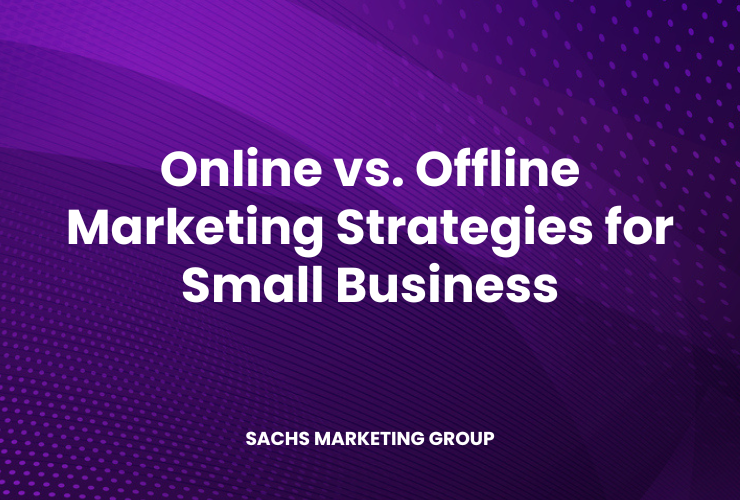There are clear differences between online vs. offline marketing strategies for small businesses. Online marketing offers unparalleled audience targeting and analytics but demands digital savvy and constant adaptation to evolving platforms. Offline marketing strategies provide a tangible, personal touch and local impact but often come with higher costs and challenges in tracking ROI.
Are you considering the differences between online vs. offline marketing strategies for your small business?
Understanding the differences, benefits, and challenges is crucial for small businesses aiming to maximize their reach and impact. In today’s digital age, digital marketing may be essential for many businesses, but that’s not to say offline marketing isn’t for certain types of businesses.
In this article, we explore online vs offline marketing strategies, outlining the differences, benefits, and challenges.
Overview
What is Online Marketing?
Online marketing is a strategy that leverages the Internet to promote products or services.
It encompasses various digital channels like social media, email, search engines, and websites. This approach enables businesses to reach a broader, targeted audience efficiently, track campaign performance in real time, and adjust strategies based on data-driven insights while often reducing traditional advertising costs.
Online Marketing Strategies
Today, online marketing strategies are vital for small businesses looking to expand their reach and connect with more customers.
These strategies encompass various activities, from social media engagement and content creation to search engine optimization and email marketing. They allow businesses to target specific demographics, track campaign performance, and quickly adapt to market changes.
The benefits include cost-effectiveness, broad reach, and the ability to engage with customers directly. This dynamic and interactive approach caters to the evolving consumer behaviors in the digital landscape.
Here are some examples of effective online marketing strategies for small businesses.
Social Media Marketing
Social media marketing is a dynamic tool for small businesses, offering a platform to engage directly with their audience.
It involves creating and sharing content on social media networks like Facebook, Instagram, and X (formerly Twitter) to achieve marketing and branding goals.
This approach allows businesses to build a community, engage with customers, and increase brand awareness. By leveraging the interactive nature of social media, businesses can foster customer loyalty and gather valuable feedback.
The key to success lies in understanding each platform’s unique audience and tailoring content accordingly. Social media also provides targeted advertising options to reach specific demographics effectively.
Search Engine Optimization (SEO)
Search Engine Optimization (SEO) is crucial for increasing a website’s visibility in search engine results and attracting more organic traffic.
It involves optimizing various website elements, including content, structure, and technical setup, to rank higher for relevant keywords. Effective SEO requires understanding search engine algorithms, keyword research, and creating high-quality, relevant content.
It’s a long-term strategy that, when done correctly, provides sustained organic traffic growth.
SEO is not just about search engines but also about providing a better user experience, essential for converting visitors into customers.
Email Marketing
Email marketing remains a powerful tool for small businesses, offering direct communication with customers and prospects.
It involves sending personalized, targeted messages to a segmented audience, fostering relationships, and encouraging loyalty. Email marketing is highly versatile, allowing for newsletters, promotional offers, event invitations, and more. Its success hinges on compelling content and a well-maintained subscriber list.
The ability to track open rates, click-through rates, and conversions makes it a measurable and cost-effective strategy. Moreover, email marketing can be automated, allowing for efficient customer nurturing over time.
Content Marketing
Content marketing focuses on creating and sharing valuable, relevant, consistent content to attract and retain a clearly defined audience.
It’s about storytelling and providing information that adds value to your customers’ lives, establishing your brand as a thought leader in your industry.
This strategy can include blog posts, videos, podcasts, infographics, and more. Effective content marketing builds trust with your audience, improves brand awareness, and encourages customer engagement.
Producing content that resonates with your audience’s interests and needs drives profitable customer action.
Pay-Per-Click Advertising (PPC)
Pay-per-click (PPC) advertising is an online marketing model where advertisers pay each time a user clicks on one of their ads.
This model offers a fast way to drive traffic to a website, unlike organic methods such as SEO. PPC ads can appear in search engine results, on social media platforms, and other websites.
They are highly targeted, allowing businesses to reach specific audiences based on keywords, demographics, and interests.
The ability to control spending, track ROI, and make real-time adjustments makes PPC an attractive option for small businesses. However, it requires careful management to optimize campaigns and control costs.
Benefits and Challenges of Online Marketing
Online marketing offers numerous advantages, especially for small businesses looking to maximize their reach with minimal resources.
Benefits:
- Targeted Advertising
- Measurable Results
- Cost-Effective
- Global Reach
- Quick Adaptation
Challenges:
- High Competition
- Constantly Evolving Trends
- Technical Complexity
- Risk of Negative Feedback
- Information Overload
What is Offline Marketing?
Offline marketing refers to traditional advertising methods that don’t involve the Internet.
This includes tactics such as print ads in newspapers and magazines, television and radio commercials, billboards, direct mail, and networking events.
It’s characterized by its ability to provide tangible, personal experiences and reach local audiences, but often at a higher cost and with less precise audience targeting.
Offline Marketing Strategies for Small Business
Offline marketing strategies remain essential for small businesses seeking to establish a strong local presence and build personal connections with their audience.
These strategies leverage traditional media and personal interactions, such as print advertising, direct mail campaigns, networking events, and local sponsorships. They offer the advantage of tangible, memorable experiences that can have a lasting impact on the consumer.
Despite being often more costly, these methods build brand loyalty and trust within a community. Offline marketing strategies provide a complementary balance to online efforts, enhancing overall brand visibility.
Here are some examples of successful offline marketing strategies for small businesses.
Networking Events
Networking events are invaluable for small businesses looking to build relationships and increase visibility within their community or industry.
These events offer a platform for personal interaction, allowing business owners to connect directly with potential clients, partners, and industry peers. They provide an opportunity to share expertise, learn about market trends, and foster collaborations.
Effective networking can lead to referrals, joint ventures, and long-term relationships crucial for business growth. Attending local business gatherings, industry conferences, and community events are great ways to start.
Remember, the key to successful networking is attending, actively engaging, and following up.
Direct Mail Campaigns
Direct mail campaigns offer a personalized approach to reaching potential customers.
This strategy involves sending physical promotional materials, like brochures, postcards, or catalogs, directly to a targeted mailing list. It stands out in the digital age by providing a tangible touchpoint with customers.
Direct mail can be highly effective for local businesses, allowing them to reach specific demographics in their community. When combined with compelling design and a clear call-to-action, these campaigns can significantly increase brand awareness and drive sales.
Tracking response rates through methods like unique codes or phone numbers also helps measure the campaign’s effectiveness.
Print Advertising
Print advertising, encompassing newspapers, magazines, flyers, and billboards, offers small businesses a traditional yet powerful medium. It provides a tangible and lasting impression that digital advertising often needs to improve.
Print ads are particularly effective in targeting local markets or niche audiences through community newspapers or specialty magazines. The key lies in crafting a compelling message with an attractive design that resonates with the target audience. Moreover, print ads often have a longer shelf life, with readers returning to them multiple times, increasing the potential for brand recall.
Strategic placement in relevant publications can maximize visibility and impact.
Sponsorships
Sponsorships provide a unique avenue for small businesses to boost brand recognition and demonstrate community involvement.
Businesses can align themselves with community values and interests by sponsoring local events, sports teams, or charitable causes. This strategy not only enhances visibility but also builds goodwill among potential customers. Sponsorships can range from financial support to providing products or services, offering flexibility in how businesses can participate. In addition to brand exposure, sponsorships often offer networking opportunities with other sponsors and attendees.
The key is to choose events or causes that align with the business’s values and target audience for maximum impact.
Trade Shows
Trade shows are a potent tool for small businesses to showcase their products or services, network with industry professionals, and gain valuable insights into market trends.
These events bring together a concentrated audience interested in a specific industry, providing an excellent opportunity for direct customer interaction and lead generation.
Exhibiting at a trade show requires careful planning, from designing an engaging booth to preparing compelling product demonstrations or presentations.
Participation in trade shows can also enhance a business’s credibility and establish it as a serious player in the industry. To maximize ROI, businesses should promote their presence before the event and follow up with leads post-event.
Benefits and Challenges of Offline Marketing
Offline marketing offers unique advantages and challenges crucial for businesses to understand.
Benefits:
- Lasting physical presence and visibility.
- Builds personal connections and trust.
- Effective for targeting local markets.
- Reaches demographics less active online.
Challenges:
- Higher costs compared to many online strategies.
- Difficulties in tracking and measuring campaign effectiveness.
- Only local reach if scaled significantly.
- Requires substantial upfront investment in design and distribution.
Online vs. Offline Marketing: Which Is Right for Your Business?
Deciding between online and offline marketing depends on various factors specific to your business, such as your target audience, budget, and marketing goals.
Online marketing is ideal for businesses looking to reach a broad audience cost-effectively, with the added advantage of detailed analytics and targeting capabilities. It suits digital-native businesses or those whose audience spends significant time online.
Conversely, offline marketing is more suitable for businesses aiming to establish a strong local presence or target demographics less engaged in the digital world. For many, a hybrid approach combining both online and offline strategies can be the most effective, leveraging the strengths of each to create a comprehensive marketing plan.
The decision should align with where your audience will likely engage with your brand and where you can most effectively convey your message.
Need Help Marketing Your Small Business?
Need help finding the perfect marketing strategy for your business? At Sachs Marketing Group, we understand the unique challenges small businesses face.
As a full-service digital marketing agency, we provide tailored solutions to amplify your online and offline presence. Let us help you navigate the marketing maze with our expertise.
Contact us today, and let’s grow your business together!
Conclusion
Online and offline marketing strategies offer unique benefits and face distinct challenges, making them indispensable tools for small businesses.
While online marketing provides cost-effective, measurable, and targeted approaches, offline marketing offers personal engagement and tangible brand experiences. For business owners, the key is to evaluate which blend of these strategies aligns best with their business goals, target audience, and budget.
Understanding and leveraging the strengths of each can create a comprehensive marketing plan that maximizes reach and impact.
Consulting with a marketing professional can help guide you through the benefits of online vs. offline marketing, ensuring you create an effective marketing strategy for your business’s success.
2 Comments
Leave a Reply
Contact us today to get the conversation started!














In today’s dynamic marketplace, small businesses face the challenge of choosing between online and offline marketing strategies.
While offline methods like print ads, direct mail, and local events offer tangible visibility within specific communities, online strategies such as social media marketing, search engine optimization (SEO), and email campaigns provide broader reach and precise targeting capabilities.
While offline efforts can build local rapport, online tactics offer scalability, measurability, and cost-effectiveness. The ideal approach often blends both worlds, leveraging the strengths of each to create a holistic marketing strategy tailored to the business’s unique goals and audience.
Agree! It’s all about balance. Thanks for reading!